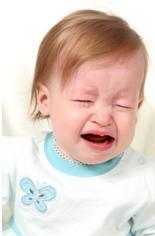Toddler Biting

Learn how to respond to toddler biting, a common child behavior problem, by using effective discipline methods, so you can get through the terrible twos and troublesome three stages without entirely losing your sanity!
At times, biting may occur with toddler temper tantrums, but not always. Both can be extremely distressing because when children are younger they are just learning how to communicate their likes and dislikes, which can be very difficult with such a limited vocabulary. As a result, it can often lead to behavior problems. This may start initially because of teething and the need to bite objects, but with reinforcement, it can worsen over time.
Why does toddler biting occur?
Biting may often occur along with toddler hitting, as a way to express wants and needs. Then unfortunately, the behaviors are often immediately reinforced by other things.
This happens by the behavior either getting another individual to leave the offender alone, getting an entertaining reaction from the victim, or possibly getting a desired toy after biting someone.
Toddlers are also usually still in the stage where they use their mouths to explore the environment, so it only seems natural that they may use biting as a way to control the environment. Other possible reasons for biting may be due to observing the behavior in older siblings/friends at daycare or when new teeth are coming in.
How to respond
I have found that it is important to make sure to avoid a reaction that includes anger or frustration when responding to biting. If the child is trying to get a toy or get another child to leave him/her alone and bites out of frustration, then teaching him/her the right words to say.
You can do this by teaching them to ask for “Help,” from an adult or say “Toy please?” However, an adult will want to monitor to ensure that these behaviors are reinforced and the child actually gets the help he or she wants or a turn with the toy.
If the toddler biting appears to be for no apparent reason and occurs simultaneously with laughter or a smile, then the child is most likely getting reinforcement out of the reaction from the individual he/she is biting. You may also consider using the following techniques for the persistent biter that doesn’t respond to redirection or stop when told this is unacceptable behavior (e.g. “No biting, that hurts”)
• Maintain a neutral facial expression and immediately walk away from the offender while saying something with only empathy, such as “That is so sad.”
• Remove any other individuals from the environment along with any current activity items from the area.
• Stand away from the child without providing any direct attention, but still making sure that the child is safe for 1-2 minutes.
• As long as he/she is calm, return and resume normal activity. If the toddler bites again repeat until the child engages in play appropriately.
• Praise appropriate play and interactions by saying something, such as “I love it when you play nice!”
These techniques may also work with children diagnosed with Down Syndrome or autism, but require some additional repetition and focus on communication strategies for toddler biting.
Additional ideas for responding to typical toddler behavior can be found on the temper tantrums page.